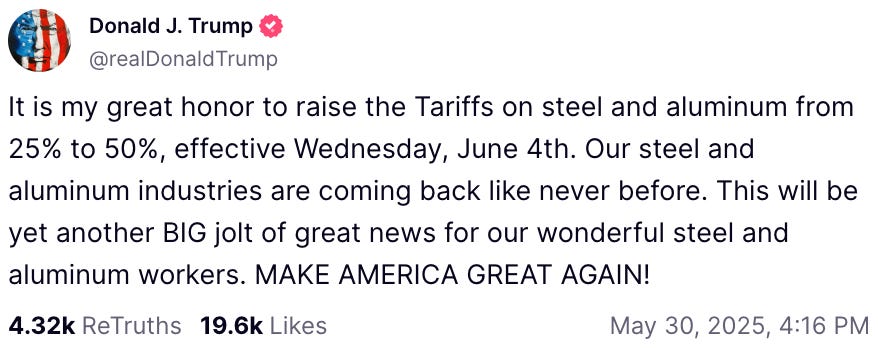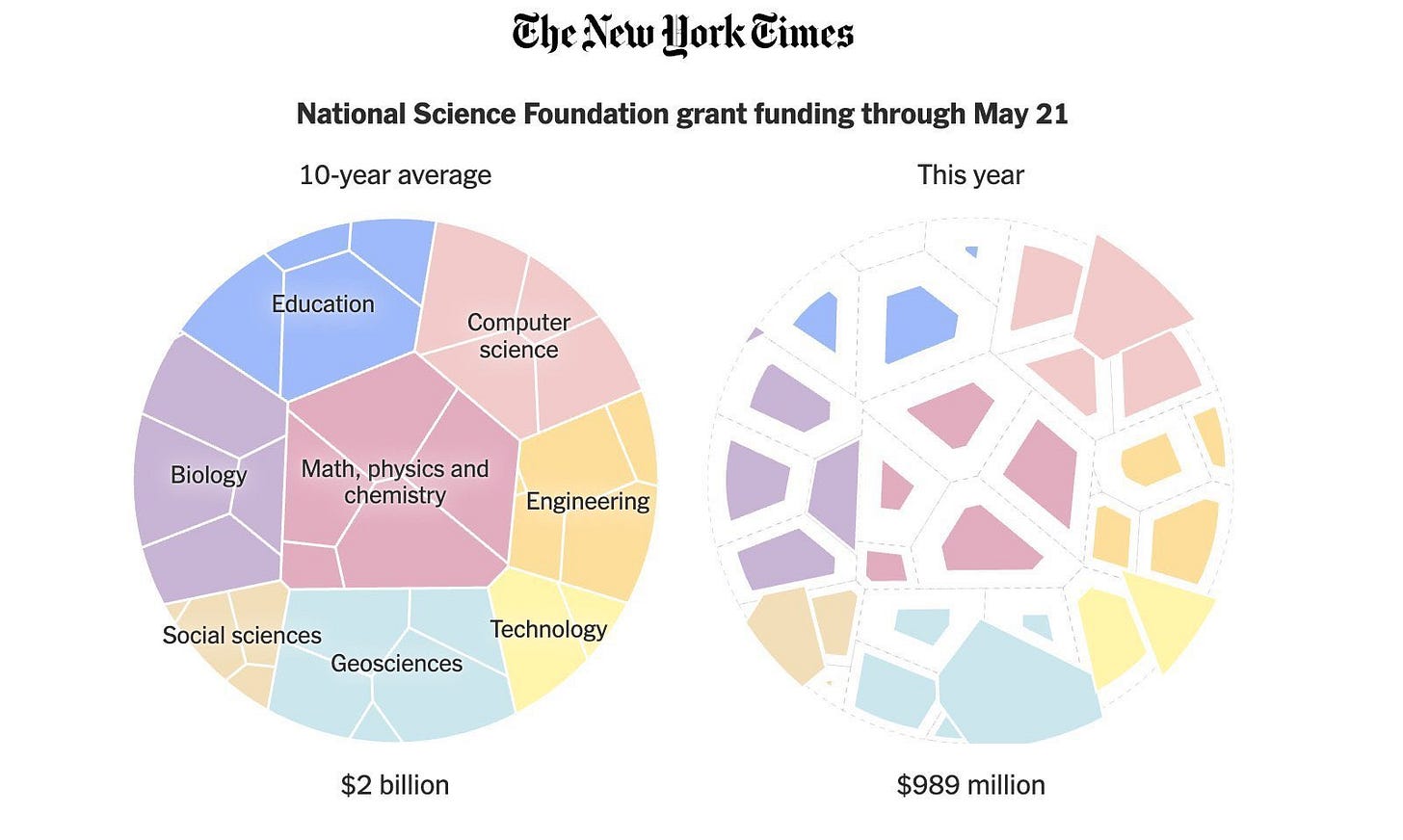Scarcity, Scarcity and More Scarcity
The Real Cost of America's New Degrowth Agenda
In the first half of 2025, President Trump has unleashed a series of aggressive trade measures and domestic policy maneuvers that are reshaping the economic landscape. From the House passage of his ambitiously named “One Big Beautiful Bill” (OBBB) to sweeping new tariffs on imports from China, cars, steel, and U.S. allies, these moves mark a sharp turn toward economic nationalism. However, Trump’s actions are creating forced scarcity – artificially constraining supply in markets and driving up costs, with ripple effects on consumer spending, industrial disruption, and potential long-term economic contraction.
The ‘One Big Beautiful Bill’ Clears the House
Trump scored a key political victory on May 22, 2025, when the House of Representatives passed the One Big Beautiful Bill Act (OBBB) by a razor-thin 215–214 vote. This 1,000-page budget reconciliation package bundles together a broad swath of the Trump agenda. It makes permanent the major tax cuts from the 2017 Tax Cuts and Jobs Act and introduces further business tax breaks, while significantly cutting non-military spending. The bill imposes stricter work requirements on social programs and is projected to remove millions from Medicaid and food stamp rolls over the next decade. At the same time, OBBB boosts defense funding and rolls back many clean-energy incentives from the Inflation Reduction Act.
While Republicans hailed the bill as a pro-growth roadmap, its fiscal impact has raised alarms. The Congressional Budget Office estimated OBBB would add $2–4 trillion to the national debt in coming years. While we have recently dubbed the OBBB as the “Reverse Robin Hood” bill. The package also earmarks funding for mass deportations and deregulation. As it stands, OBBB’s mix of large tax cuts and deep spending reductions sets up a clash between stimulating growth and courting fiscal instability.This fiscal recklessness is driving up interest rates and borrowing costs, pricing out middle-class families from homeownership, car purchases, and business loans while handing massive tax breaks to those who need them least.
Legal Challenges and Tariff Escalation
In the background of this all, Trump's initial trade strategy faced a significant legal setback when the U.S. Court of International Trade struck down his "Liberation Day" tariffs, ruling that his use of the International Emergency Economic Powers Act (IEEPA) to address routine trade deficits constituted an unconstitutional overreach. The court found that declaring trade deficits a national emergency lacked both statutory and constitutional justification.
The ruling was a major victory for trade litigants, including a coalition of small businesses represented by the Liberty Justice Center, who argued that the tariffs were inflicting “grave and irreparable harm.” The court sided with them, citing violations of the nondelegation doctrine and rejecting Trump’s expansive reading of IEEPA.
However, that victory is far from final. Within 24 hours, a federal appellate court issued a temporary stay, allowing the tariffs to remain in place pending further legal review. Trump’s legal team has since appealed the ruling, setting up what could be a prolonged and consequential legal battle over the scope of presidential tariff powers. Even if the courts ultimately uphold the initial decision, the appeal process could stretch for months during which the tariffs will continue to impact U.S. businesses, consumers, and trade relationships.
As Gary Winslett has recently noted in the Washington Post, the Trump admin has started their focus on “option 2”: It could also sidestep the other branches of government and turn to slower statutory tools such as Section 232 national security investigations, Section 122 balance-of-payments procedures and traditional antidumping cases as a basis for its tariffs. The Trump administration is already using 232 to increase tariffs on steel and aluminum; there’s a good chance it will ramp these up on other products very quickly. The bad news for American consumers is that these are still quite exploitable by an administration hell-bent on autarky.
And just as expected, Trump doubled down and now in effect tomorrow, he is increasing steel and aluminum tariffs from 25% to 50% under Section 232 national security provisions.
The administration has also already launched Section 232 investigations into other strategic sectors like pharmaceuticals, semiconductors, and critical minerals, laying the groundwork for more such actions.
The tariff increase affects critical supply chains across multiple industries. The Can Manufacturers Institute warns that the higher aluminum costs will drive up food prices for millions of Americans, while the Aluminum Association projects threats to $10 billion in downstream investments. European allies are preparing retaliatory measures, escalating trade tensions with key partners.
The Degrowth Doctrine: Scarcity as Virtue
Perhaps most striking is the administration's explicit embrace of reduced consumption as a policy goal. Trump and his top advisors are no longer hiding the effects of these policies. This rhetoric mirrors the worst impulses of left-wing degrowth, except with none of the environmental rationale. It’s a cultural shift rooted in economic contraction: the idea that Americans should simply “make do” with less as a form of nationalistic virtue.
He’s not just canceling clean energy incentives and cutting federal R&D; he’s weaponizing scarcity as a governing philosophy. The result isn’t self-sufficiency — it’s imported inflation, slower growth, and a creeping sense that prosperity is being rationed.
The scale of Trump's assault on scientific research and innovation is staggering. The dramatic cuts to the National Science Foundation (NSF), with funding collapsing from $2 billion in the 10-year average to just $989 million this year a devastating 50% reduction that eviscerates research across education, computer science, biology, math, physics, chemistry, engineering, social sciences, geosciences, and technology. It's a deliberate dismantling of America's innovation infrastructure.
Image Credit: The New York Times
These NSF cuts represent a fundamental rejection of the idea that America should lead in scientific discovery and technological advancement. Computer science research, critical for AI development and tech competitiveness, faces massive reductions just as China and other competitors are ramping up their investments. Engineering and technology research, essential for manufacturing innovation and clean energy breakthroughs, are being gutted. Even basic research in biology and chemistry, which drives pharmaceutical breakthroughs and medical advances, is on the chopping block.
The message is clear: Trump's America will be a place where scientific curiosity is a luxury we can't afford, where research that doesn't produce immediate commercial returns gets eliminated, and where the next generation of innovations will happen somewhere else. This is economic self-sabotage disguised as fiscal responsibility. Countries that cut research spending don't become more competitive, they become irrelevant. While wealthy Americans can still access cutting-edge treatments and technologies developed abroad, working families will be left with the consequences of a country that chose ideology over innovation.
Meanwhile, the clean energy rollbacks in OBBB go far beyond simple deregulation. The bill systematically dismantles the Inflation Reduction Act's incentives for solar, wind, battery storage, and electric vehicle infrastructure. Tax credits that were spurring a manufacturing renaissance in red states like Georgia, Texas, and Ohio are being eliminated, killing jobs and private investment that was already flowing.
If Trump’s OBBB is the blueprint for a domestic austerity regime, his 2025 trade strategy is the execution plan. Together, they form a cohesive economic doctrine: constraint disguised as patriotism. OBBB slashes support systems, rolls back clean energy, and undermines affordable care while Trump’s trade war inflames supply chains and burdens consumers with higher prices. The tariffs aren’t a sideshow. They’re the inflationary fuel for a degrowth agenda that punishes Americans for wanting more. It's a conscious choice to make America less dynamic, less innovative, and less prosperous over time. All so that Trump can say he owned the libs; it’s his culture war over your wallet.
The policy clash between Trump’s scarcity economics and the abundance agenda has come into full view. On one side: Trump’s One Big Beautiful Bill, which slashes social spending, guts clean energy, and greenlights mass deportations, all while turbocharging corporate tax cuts. On the other: a Democratic message that, so far, has lacked urgency in confronting the new era of forced scarcity.
The Liberal Case for More, Not Less
Abundance liberals are uniquely positioned to take the fight to Trump. As Noah Smith has recently noted:
“Trump is the anti-abundance President. Which means that abundance liberals need to train their fire on Trump, rather than spending all their time snarking at progressive critics who didn’t read their book. No, the progressive critics didn’t read the book, but pointing that out won’t make abundance liberalism the standard-bearing ideology of the Democratic party.
What will make abundance liberalism the standard-bearing ideology of the Democratic party is to take the lead in the fight against the party’s external enemies. This is what Barack Obama did in 2008 — he won the primary against Hillary Clinton primarily because he, instead of Hillary, became the avatar of Democratic anger against the Iraq War. But becoming the standard-bearer doesn’t always mean putting hot-button wedge issues front and center — candidates who emphasized deficit reduction and middle-class prosperity dominated the 1992 Democratic primary, because this was the most effective line of attack against George H.W. Bush.
Abundance liberals can also take a page from history here. The progressive movement of a century ago focused on bringing costs down for average Americans. Fighting monopolies and trusts was part of that effort, for sure. But so was reducing tariffs. Bob La Follette crusaded against tariffs, and the progressive muckraker Ida Tarbell — depicted at the top of this post with lasers shooting out of her eyes — wrote a whole book about why tariffs are bad.”
Democrats must relentlessly highlight how Trump's tariffs and the OBBB directly harm American households in their daily lives. The messaging should be concrete and visceral: when families go to the grocery store and see higher prices on canned goods because of the 50% aluminum tariff, that's Trump's scarcity agenda at work. When middle-class families can't afford a new car because Trump added $6,400 to the price through automotive tariffs, that's the real cost of his "America First" rhetoric.
The OBBB's impact on households is equally devastating and must be hammered home. When millions lose Medicaid coverage and can't afford healthcare for their children, when food stamp cuts leave families choosing between groceries and rent, when clean energy jobs disappear in states that desperately need economic development, these aren't abstract policy debates. These are kitchen table issues that affect real families trying to get ahead.
Democrats should connect these policies to Trump's explicit degrowth messaging. When Trump tells parents their children should have "two dolls instead of 30 dolls," Democrats should ask: why is the President of the United States telling American families they should expect less? Why are we the only developed country whose leader promises scarcity instead of prosperity?
Trump's economic agenda represents a coherent and backwards vision of American prosperity based on constraint rather than expansion. By explicitly embracing scarcity as virtue and implementing policies that reduce consumer choice and increase costs, the administration has created a clear ideological divide with traditional growth-oriented economics. Democrats who seize this moment to champion abundance over scarcity, prosperity over constraint, will find themselves on the winning side of this fundamental debate about America's economic future.




